|
america's dynamic workforce: 2006 |
A notable feature of the
U.S. labor market is its constant activity as people freely move in and
out of the labor market, as total jobs grow, and as workers change
jobs. High turnover in the United States – as evidenced by high levels
of both separations and hires – partially reflects broad changes over
time in the economy’s industry and occupation patterns. As the
historical employment shift away from the goods-producing sector
continues, new employment patterns emerge.
Robust employment growth is the
norm. Over the past half-century (1955 to 2005) payroll employment increased
from 50.7 million to 133.5 million as our growing population found new jobs in a
growing economy. The total number of jobs has doubled since 1967, and over the
most recent 15 years (1990 to 2005) total payrolls increased by 22 percent.
However, robust total job growth has masked significant changes in the
industrial and occupational structure of the labor market. Employment growth
rates have varied widely among industries as changing demand, technology and
global competition have reshaped the labor market.
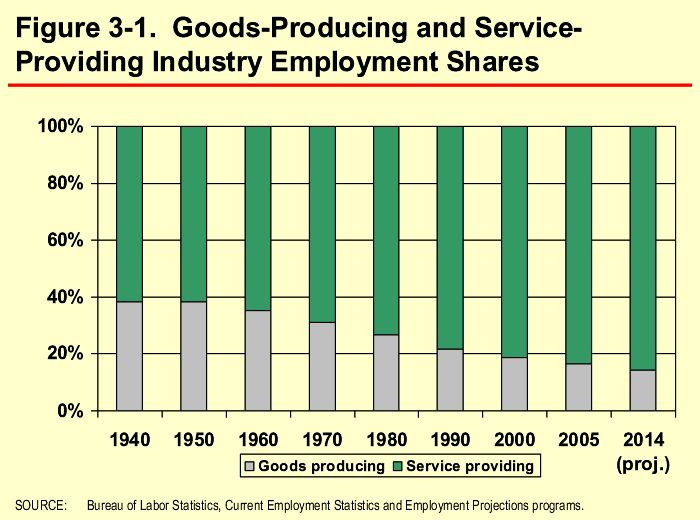
-
The service sector accounted for 62 percent of nonfarm payroll
employment in 1940, and that share rose to 83 percent in 2005. The
service sector share of payroll employment is projected to rise to
nearly 86 percent by 2014.
-
From 1940 to 2005, total employment grew in both the goods-producing
and service-providing sector, but the overwhelming majority of net
new jobs have been in the service sector. From 1940 to 2005, 9.8
million net new jobs were created in the goods- producing sector,
and 91.3 million net new jobs were created in the service-providing
sector.
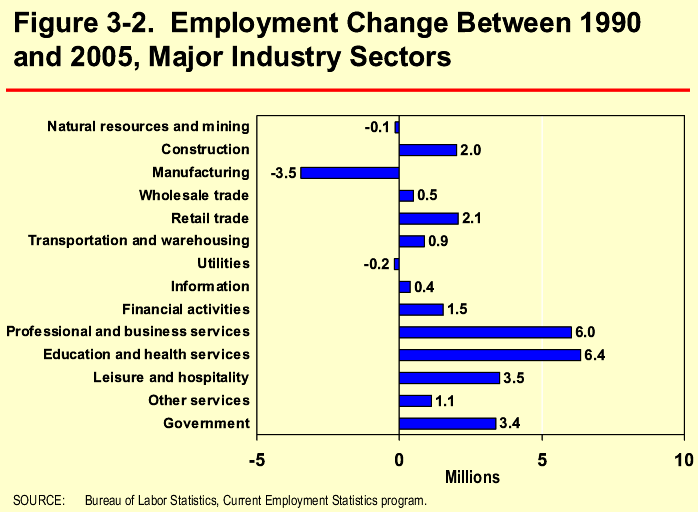
-
The on-going shift of the industrial structure of employment is
evident even during the 1990-2005 period. The 6.0 million increase
in employment for the professional and business services industry
sector and the 6.4 million increase in employment for the education
and health services sector stand in contrast to net job losses for
manufacturing. Those two sectors accounted for over half (51.7
percent) of net nonfarm payroll employment growth over the past 15
years.
-
In 2005, the 17.3 million jobs in the private education and health
industries sector accounted for 13 percent of all payroll jobs and
comprised the second largest of the major sectors.
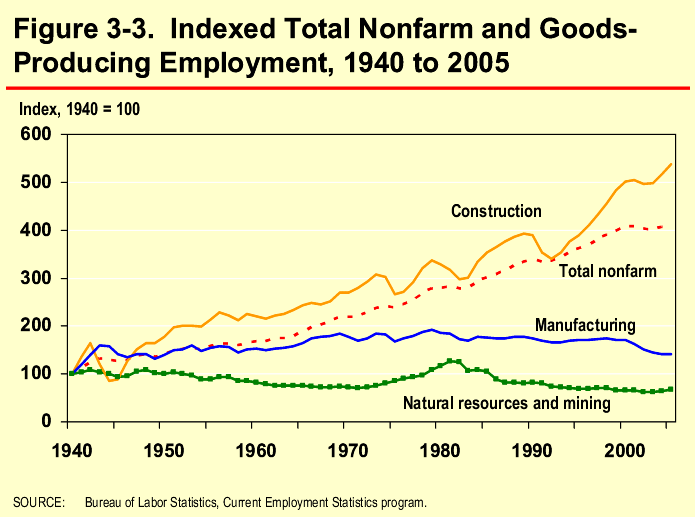
-
Construction job growth generally has kept pace with total nonfarm
employment, with the exception of brief cyclical downturns offset by
quick recoveries. The rate of growth following the 1990-91
recession held steady through most of the decade. Only minor job
losses came in the period surrounding the 2001 recession, and rapid
job growth soon resumed.
-
In 2005, construction industry employment was more than 5 times
greater than the level in 1940. By comparison, manufacturing
employment was 41 percent higher than in 1940 and significantly
below its all-time high in 1979. At 14.2 million in 2005,
manufacturing employment reflected a steady decline over the past
quarter century of nearly 27 percent.
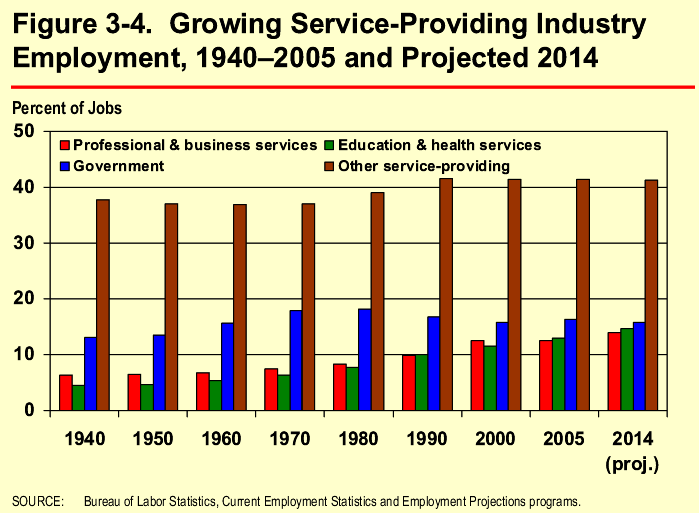
- Among the service-providing industries, two major industries stand
out for their job growth since 1990. Professional and business
services, and private education and health care and social
assistance services together represented just 10.9 percent of
nonfarm payroll employment in 1940. They represented nearly one in
five jobs by 1990 and over one-quarter by 2005.
- By 2014, they are projected to account for nearly three out of ten nonfarm
payroll jobs. The growth of these two sectors has notably exceeded the
growth of government (the leading services sector in terms of employment)
and all other private service industries.
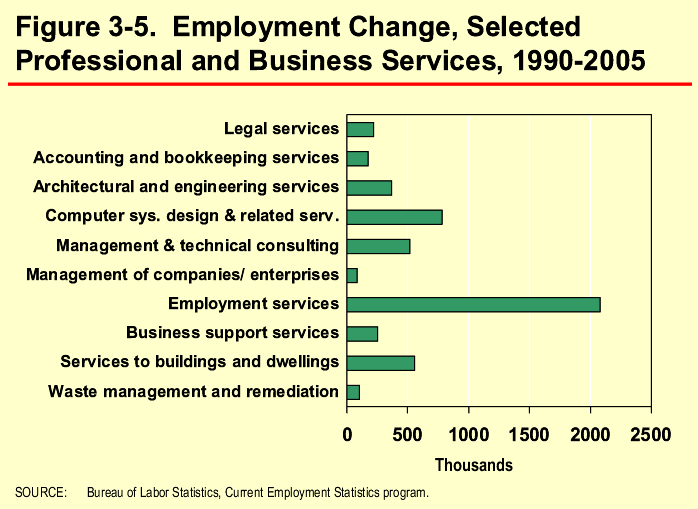
-
Payroll employment throughout professional and business services has
expanded notably over the past decade and a half.[11]
Within the sector, only travel arrangement services lost jobs, with
all the declines coming since 1998.
- Gains were especially notable in three industries: employment services; computer
systems design and related services; and management, scientific, and
technical consulting. These three industries accounted for just one-fifth
of professional and business services employment in 1990 but over half the
job gains between 1990 and 2005. This pattern is expected to continue to
2014.
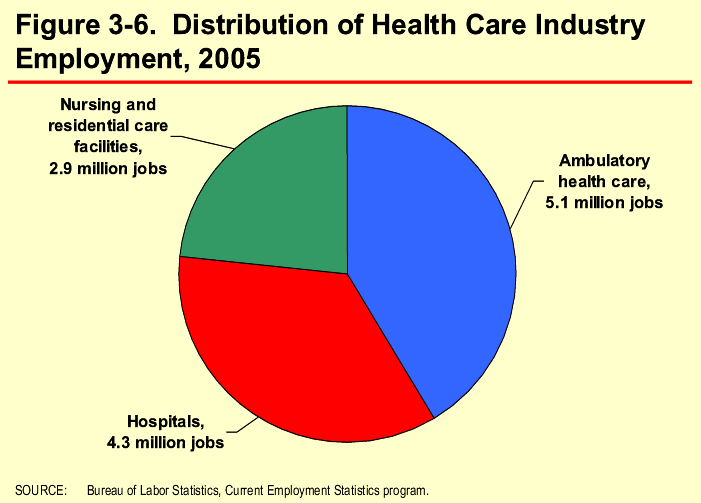
- The health care sector includes some of the largest and
fastest-growing private industries in terms of employment. With
12.3 million payroll employees in 2005, the private health care
industry comprised 9.2 percent of all payroll jobs. Overall health
care sector employment grew by 4.1 million between 1990 and 2005 – a
50 percent increase.
- The ambulatory care industry group grew by 80 percent (2.3 million
jobs) from 1990 to a total of 5.1 million jobs in 2005, making it
the largest subcategory within health care. This industry includes
offices of physicians and other health practitioners, outpatient
care centers, medical laboratories, and home health care services.
- Private hospitals added 834,000 jobs from 1990, bringing 2005 hospital
employment to 4.3 million, a 23.8 percent increase. Nursing and residential
care facilities added 1.0 million jobs, a 54 percent increase that brought
total employment in nursing and residential care facilities to 2.9 million
in 2005.
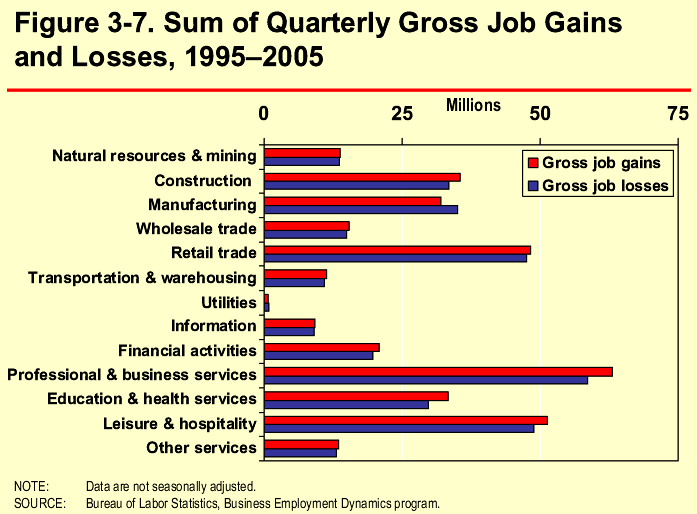
- Between first
quarter 1995 and third quarter 2005, job creation because of the
opening of new establishments or the expansion of existing ones
totaled 352 million, and job elimination because of closing of some
establishments or reductions in numbers of jobs at others totaled
337 million.[12]
The flows of job creation and elimination somewhat mirrored the
patterns of net job creation, but not entirely.
- With gross job gains of 63.1 million and gross job losses of 58.6 million, the
growing professional and business services industry experienced both
the greatest jobs creation and elimination among major industries,
as competition sorted out business successes and failures.
- It is notable, also, that manufacturing, which experienced net employment decline,
also experienced relatively high levels of job creation in parallel
with job elimination. In manufacturing 35.1 million jobs were
eliminated in aggregate during the period, but job gains in new or
expanding establishments totaled 32 million.[ii]
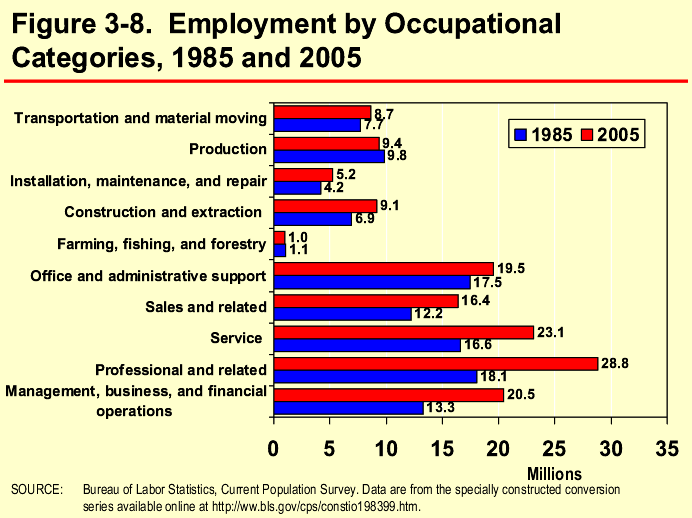
-
Over the past 20 years the major occupation groups with both the
fastest percentage growth and the largest numerical increase in
employment were professional and related occupations and management,
business and financial operations occupations.[14]
- Professional and related occupations accounted for 20.3 percent
(28.8 million) of total employment in 2005, up from 16.9 percent in
1985. Employment growth of 10.7 million in professional and related
occupations accounted for 30.9 percent of total employment growth
over the 1985 to 2005 period.
- Management, business and financial operations occupations accounted for 14.5
percent (20.5 million) of total employment in 2005, up from 12.4 percent in
1985. Employment growth of 7.2 million in management, business and
financial operations occupations accounted for 20.8 percent of total
employment growth over the period.
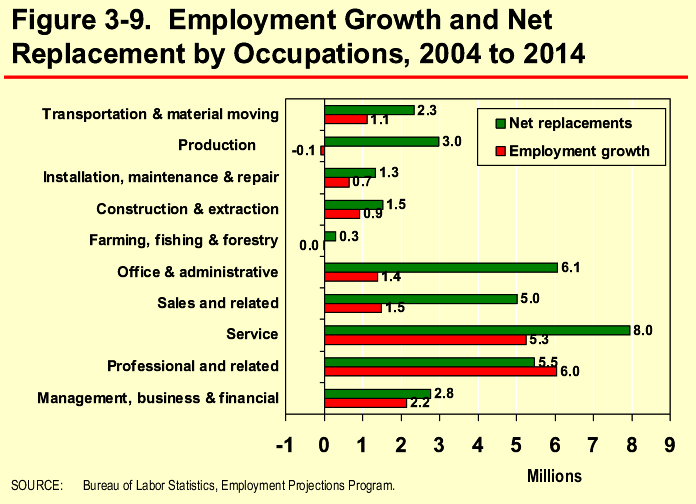
-
Employment is projected to grow by 18.9 million jobs between
2004 and 2014. In addition to job growth, net replacement for
retirees and others leaving the labor force is expected to
provide another 35.8 million job openings. Together, growth
plus net replacement will yield 54.7 million cumulative job
openings.
-
Growth-related job openings over the 10-year period will be
greatest in professional and related occupations and in service
occupations. Within the professional and related occupations
category, health care workers will be especially in demand.
-
The largest major occupation category in terms of replacement needs will
be the service occupations group, with 8.0 million projected replacement
job openings.
-
Even production occupations will need workers: 2.5 million net
replacement openings are projected despite little increase in job
openings due to growth.
|












